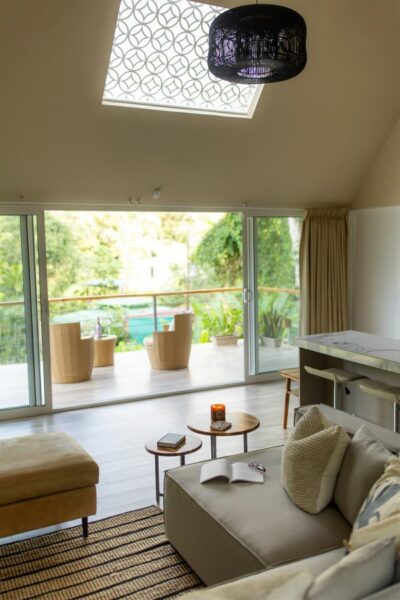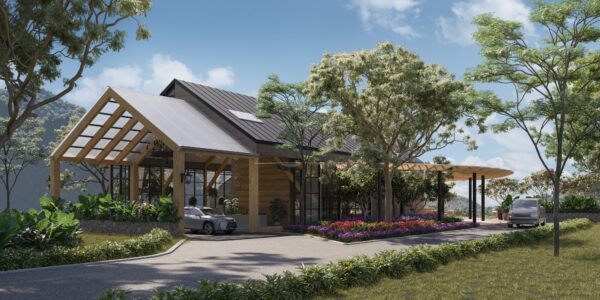
With scorching summers becoming the new normal, finding ways to keep our homes cool and comfortable is more important than ever. But how do you design a house that naturally stays cool without relying on air conditioning units? Let’s explore the top principles for creating a cooler house design that not only helps beat the heat but also promotes energy efficiency and sustainability.
From strategic orientation and smart ventilation systems to clever shading techniques and appropriate insulation, there are many design principles that can significantly reduce the need for artificial cooling. These principles not only help cooling a house but also contribute to lower energy bills and a smaller carbon footprint.
Whether you’re looking to build your dream house or renovate your existing home, as an architect in a tropical climate, let me guide you through the key principles for designing a cooler and more environmentally friendly space. Let’s unlock the secrets of a cooler house that keeps you comfortable year-round.
Climate change is here and the temperatures continue to rise, the need for effective and sustainable cooling solutions has become increasingly crucial. Traditional air conditioning systems, often come with a significant environmental cost in the form of high energy consumption and greenhouse gas emissions, let’s try to avoid that as much as possible! And, the reliance on these systems can lead to skyrocketing utility bills, making it a financial burden.
Designing a house that can naturally stay cool without excessive air conditioning not only helps mitigate the environmental impact but also offers long-term cost savings and improved comfort for the occupants. By incorporating principles of passive cooling, architects can create a living space that is tailored to the local climate.
A cooler house design can have far more benefits beyond just temperature control. It can enhance indoor air quality and contribute to the overall well-being of the user. In an era where sustainability and environmental consciousness are crucial, designing a house that can beat the heat without excessive energy consumption is not only a practical solution but also a responsible choice for homeowners and the planet.
Now, designing a cooler house is not a one-size-fits-all recipe, as the specific strategies and principles used will vary based on the local climate, site orientation, and architectural style. However, there are several key principles that can be universally applied to create a more comfortable and energy-efficient living space. Let’s look into these principles in detail:
One of the fundamental principles of a cooler house design is of course maximizing natural ventilation. By strategically positioning windows, doors, and other openings, homeowners can harness the power of natural air to circulate throughout the home. This can be achieved through the use of cross-ventilation, where windows and doors are positioned on opposite sides of the house, allowing for a continuous flow of air.
Another effective strategy is the incorporation of high-level openings, such as skylight windows or roof vents, which can create a stack effect. This happens when warm air rises and escapes through the upper openings, drawing in cooler air from the lower levels of the house. By carefully designing the placement and size of these openings, an architect can create a natural cooling system that reduces the need for mechanical air conditioning.
Additionally, the use of operable windows and doors, coupled with the strategic placement of fans, can enhance the natural ventilation within the home. This allows the users to take advantage of cool breezes and create a comfortable indoor environment.
On the photo below, you can see the glass sliding doors I placed on this design, which are part of a crossed ventilation system, with the windows on the other side of the space. Along the high ceilings and the crossed ventilation, this space keeps super cool even in the hottest of summer days, plus we get a lot of natural light, helping to keep the space free of humidity.

Shading is another crucial principle in the design of a cooler house. By strategically blocking the sun’s rays from entering the home, architects can significantly reduce the amount of heat that penetrates the interior spaces. This can be achieved through a variety of shading techniques, including:
Overhangs and awnings: Designing roof overhangs or installing awnings over windows and doors can create effective shading, blocking the sun’s rays during the hottest parts of the day.
Trees and vegetation: Planting strategically placed trees can provide natural shading during the summer months.
Exterior shading devices: Shutters, louvers, or screens installed on the exterior of the home can be adjusted to control the amount of sunlight entering the interior spaces.
Interior shading: Curtains, blinds, or shades can be used on the inside of windows to reduce the amount of solar heat gain within the home.
By incorporating these shading techniques, architects can create a cooler and more comfortable living environment.
On the image below, you can appreciate how I used a wood pergola as a shading technique for this house, to keep the sun light from going directly on the windows.

The choice of building materials plays a crucial role in the overall performance of a home. Using energy-efficient materials can significantly contribute to a cooler house design. Some key considerations include:
Reflective roofing: Using light-colored or reflective roofing materials, such as metal or cool roof systems, can help reduce the amount of heat absorbed by the home, keeping the interior spaces cooler.
Insulation: Proper insulation, both in the walls and ceiling, can greatly enhance the thermal performance of a home.
High-performance windows: Choosing windows with low-emissivity (low-E) coatings, double or triple glazing, and other energy-efficient features can minimize solar heat gain and improve overall insulation. There are different window companies in Costa Rica with low-E systems, like Extralum for example.
As for wall building materials, concrete or blocks are great at keeping the heat out of the house, however, they also keep the humidity inside the spaces for longer, and in a tropical climate like Costa Rica, that can be a big disadvantage. A metal frame with drywall, with the proper insulation, could be a great solution for the tropical weather.
Insulation and cool roof systems are two essential components of a cooler house design. Proper insulation helps to prevent heat transfer, keeping the interior spaces cooler during the hot summer months.
Insulation should be strategically placed in the walls, ceilings, and other areas of the home to create a continuous thermal barrier.
Also, using lighter colors on your roof, help reflect the sun light, reducing the heat transmission into the interiors. See on the picture below, how we use a light gray color for the roof sheets.

The surrounding landscape can play a significant role in the overall cooling performance of a home. Strategic landscaping can provide natural shading, enhance air circulation, and even contribute to the microclimate around the house.
One effective landscaping strategy is the use of trees and vegetation. In Costa Rica, we are blessed with a lush tropical greenery, which can be taken advantage of when cooling your house. Almendros and Guanacaste trees are very popular on the Pacific Coast side to generate great shading around the houses. Be careful with palm trees though, as their roots can cause a lot of trouble to the mechanical house system.
In addition to trees, other landscaping elements such as bushes, vines, and ground cover can help create a more comfortable microclimate around the home. These plants can help, creating pockets of cooler air and reducing the heat load on the building.
Incorporating water features, such as fountains or swimming pools, can also contribute to a cooler house design. The evaporative cooling effect of these water bodies can help lower the ambient temperature and create a more pleasant outdoor environment.

Designing a cooler house that can effectively beat the heat is not only a practical solution but also a responsible choice for homeowners and the environment. By incorporating these principles, architects can create a living space that is tailored to the local climate, leveraging natural elements and design strategies to regulate indoor temperatures and promote energy efficiency.
As global temperatures continue to rise, the need for effective and sustainable cooling solutions has become increasingly crucial. By embracing the principles of a cooler house design, homeowners can not only find respite from the scorching heat but also contribute to a more sustainable future. So, let’s beat the heat and create living spaces that are both comfortable and environmentally responsible.
Learn more about designing your dream home in Costa Rica here
Costa Rica Architect – Designing Your Dream Home in Paradise
